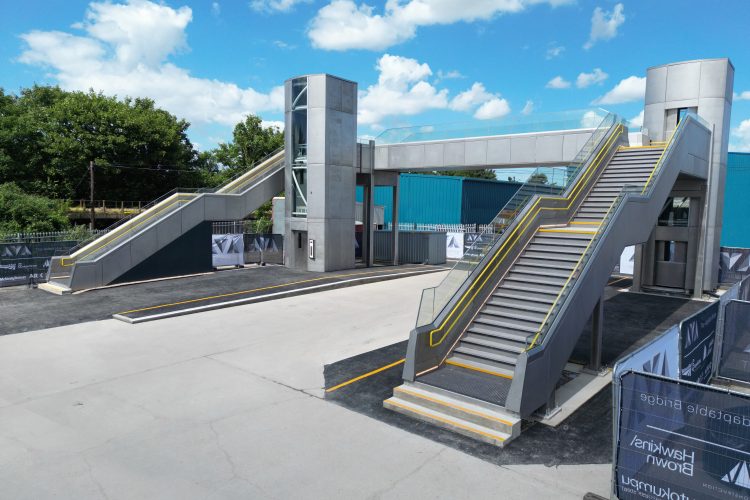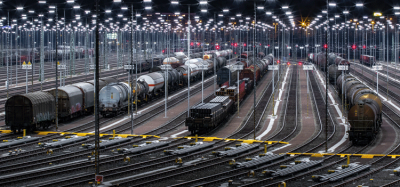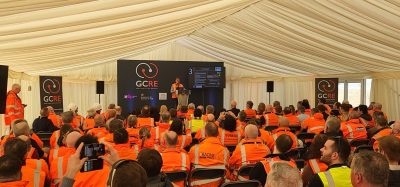Network Rail launches modular AVA Bridge to transform accessibility and sustainability at UK rail stations
Posted: 14 April 2025 | Andy Backhouse | No comments yet
Network Rail’s AVA Bridge offers a low-carbon, modular solution to modernise ageing footbridges and improve accessibility across the UK’s railway network.


default
In an ambitious effort to modernise the UK railway network’s infrastructure, Network Rail is spearheading a project that breaks with more than half a century of tradition. The AVA Bridge, a new breed of pedestrian footbridge, introduces modern manufacturing methods, new materials such as stainless steel, lower carbon emissions, and greater flexibility. The aim is to redefine how bridges are designed, built, and maintained across the UK’s railways. With Outokumpu as a key contributor, the AVA Bridge changes how rail connectivity is delivered to communities.
The problem has been long recognised: the UK has more than 1,000 small and medium-sized stations without pedestrian footbridges and a significant number of existing footbridges are in urgent need of replacement. Since the 1960s, bridge construction has followed a bespoke model — custom designs and on-site construction that demand time, money, and heavy carbon footprints. The AVA Bridge offers an innovative alternative based on a modular, factory-manufactured system designed for speed, sustainability, versatility, and aesthetic value.
A real-world shift in bridge delivery and design
The first full-scale prototype of the AVA Bridge was installed in Sittingbourne, Kent in June 2024. It serves as a real-world demonstrator, allowing Network Rail and its consortium of partners to evaluate the modular design’s performance and practicality. Driven by a vision from Network Rail’s Head of Buildings and Architecture, Anthony Dewar, and co-developed with partners such as Walker Construction, Hawkins\Brown, Expedition Engineering, ARX, and the Manufacturing Technology Centre (MTC), the AVA Bridge is setting a new precedent.
Central to the bridge’s design is the use of Outokumpu’s Forta LDX 2101 — an advanced duplex stainless steel that combines high mechanical strength with excellent corrosion resistance. This material enables the bridge sections to be lightweight, uncoated, and highly durable, eliminating the need for frequent repainting and therefore reducing maintenance costs. Given that traditional carbon steel bridges require repainting roughly every 30 years, the maintenance savings alone could be substantial.
“The AVA Bridge is not just about moving people across railway lines — it’s about bridging the gap between outdated infrastructure and the future of public transport.”
The AVA Bridge’s framework is radically different from the typical welded I-beam structure seen across most UK stations. Instead, it employs advanced digital manufacturing techniques inspired by modular systems like Meccano. Flat stainless steel sheets are laser-cut and folded into C-profiles, which are assembled using pre-loaded bolts — requiring careful re-evaluation of structural norms and even bespoke bolt manufacturing in cooperation with Bumax. With meticulous design optimisation and Outokumpu’s material expertise, the bridge’s structural components are not only robust but manufactured with minimal waste.
This plug-and-play modular system brings a number of practical benefits. The bridge’s height, span, and alignment can be adapted to the unique configurations of almost any station. The pre-built modules — span, stairs, and lifts — are delivered by truck and craned into place, reducing on-site works and minimising the number of costly “track possessions” where railway lines must be temporarily closed. The entire structural installation can often be completed within a single 27-hour possession window.
Accessibility has also been built into the bridge’s design. Configurations include wide and narrow versions to accommodate space constraints, both incorporating new, reliable lift systems developed by ARX. Through-lift access on wider versions ensures ease of use for all passengers, including those with mobility challenges or pushchairs.
Environmental and societal benefits further strengthen the case for the AVA Bridge. Its sleek, bead-blasted stainless steel finish is both durable and visually appealing. Independent assessments by Network Rail have awarded top marks to the AVA Bridge for sustainability, cost efficiency, safety, maintenance, and passenger satisfaction.
As a project that has benefited from public innovation funding, the AVA Bridge will be made open source, enabling other engineers and manufacturers to adapt and produce the design. The first operational bridge is scheduled to open at Stowmarket Station, Suffolk in summer 2025, but the long-term mission is much broader: to develop a robust domestic supply chain and spark a new era in British bridge manufacturing.
Combining structural engineering excellence, cutting-edge manufacturing, and sustainable material innovation, the AVA Bridge project is not just about moving people across railway lines — it’s about bridging the gap between outdated infrastructure and the future of public transport.
For more information: https://www.avabridge.com/
Related topics
3D Printing/Additive Manufacturing, Building Information Modelling (BIM), Digitalisation, Infrastructure Developments, Rolling Stock Orders/Developments, Station Developments, Sustainability/Decarbonisation, Technology & Software, The Supply Chain
Related organisations
ARX, Bumax, Expedition Engineering, Hawkins\Brown, Manufacturing Technology Centre (MTC), Network Rail, Outokumpu, Walker Construction








